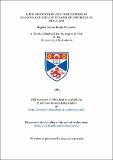Files in this item
Lipid production and composition in haploid and diploid strains of Aspergillus nidulans
Item metadata
| dc.contributor.advisor | Hunter, Marcus Ian Stuart | |
| dc.contributor.author | Monteiro, Regina Teresa Rosim | |
| dc.coverage.spatial | 142 p. | en_US |
| dc.date.accessioned | 2018-06-18T10:11:02Z | |
| dc.date.available | 2018-06-18T10:11:02Z | |
| dc.date.issued | 1985 | |
| dc.identifier.uri | https://hdl.handle.net/10023/14174 | |
| dc.description.abstract | Six auxotrophic mutants of A. nidulans were crossed in a dialell cross system to obtain heterokaryous and heterozygous diploids. In order to ascertain their lipid accumulation ability, some of these mutants and diploids were tested in a minimal medium (with 3% glucose + 0.6% NaNO3), either in a shaker or in an incubator without agitation. Both, the mutants and diploids, exhibited only 4.6% lipid, on a dry weight basis. With the aim of optimising culture conditions for lipid accumulation, a wild type was cultivated in a range of different media and cultural conditions. The best yield (about 24%), was achieved in a modified minimal medium (MM + 12% glucose + 0.1% NaNO3), with a vortex stirrer device. The lipid composition of wild type 16 grown in a fermenter was determined. The results obtained from cells grown in two different media and using two extraction methods were compared. Fractionation of the total lipid on a Florisil column showed that this strain is composed of 86% neutral lipid, 7% glycolipid and 7% phospholipid, after isopropanol (IP) extraction, whilst chloroform-methanol (CM) extraction gave 75% neutral lipid, 8% glycolipid and 17% phospholipid. A further fractionation on hydrated Florisil showed that CM extracted sterols (both free and esterified) more efficiently than IP. Therefore, CM was considered a better extraction method, particularly for protein-bound lipids. The separation of the neutral lipid fraction into sub-classes also showed that the enhanced lipid content achieved in modified minimal medium, compared with a previously reported medium, was accounted for mainly by an increase, not in the triglycerides as was expected, but in the amount of sterols. TLC analysis of glycolipid and phospholipid from IP and CM extraction demonstrated two major glycolipid components (monoglycosyl and diglycosyl diglycerides) and that phosphatidylcholine (PC) and phosphatidylethanolamine (PE) were the principal phospholipids with lesser amounts of phosphatidylinositol, phosphatidylserine, phosphatidylglycerol, cardiolipin and phospbatidic acid (PA) after CM extraction, whilst after IP extraction only PC, PE and PA were found. Another significant difference between the two extraction methods is the large amount of PA found after CM extraction, but not after IP, showing that, almost certainly, phospholipase D activity had occurred during the process of extraction and/or storage of the lipid. It was also found that the principal phospholipid attacked by the enzyme was PC. The fatty acid composition was determined by GLC. The major fatty acids found in the total lipid were: 16:0 =21%; 17:0 =5%; 18:0 =18%; 18:1 = 20%; 18:2 = 35%. Each lipid class showed a different and distinctive fatty acid composition, exhibiting variation with the growth medium and extraction method used. Of particular interest was the sterol ester fraction which contained margarinic acid (17:0) as its only fatty acid. | en_US |
| dc.language.iso | en | en_US |
| dc.publisher | University of St Andrews | |
| dc.subject.lcc | QP752.F35M7 | |
| dc.subject.lcsh | Fatty acids | en |
| dc.title | Lipid production and composition in haploid and diploid strains of Aspergillus nidulans | en_US |
| dc.type | Thesis | en_US |
| dc.contributor.sponsor | National Council for Scientific and Technological Development (Brazil) | en_US |
| dc.type.qualificationlevel | Doctoral | en_US |
| dc.type.qualificationname | PhD Doctor of Philosophy | en_US |
| dc.publisher.institution | The University of St Andrews | en_US |
This item appears in the following Collection(s)
Items in the St Andrews Research Repository are protected by copyright, with all rights reserved, unless otherwise indicated.

